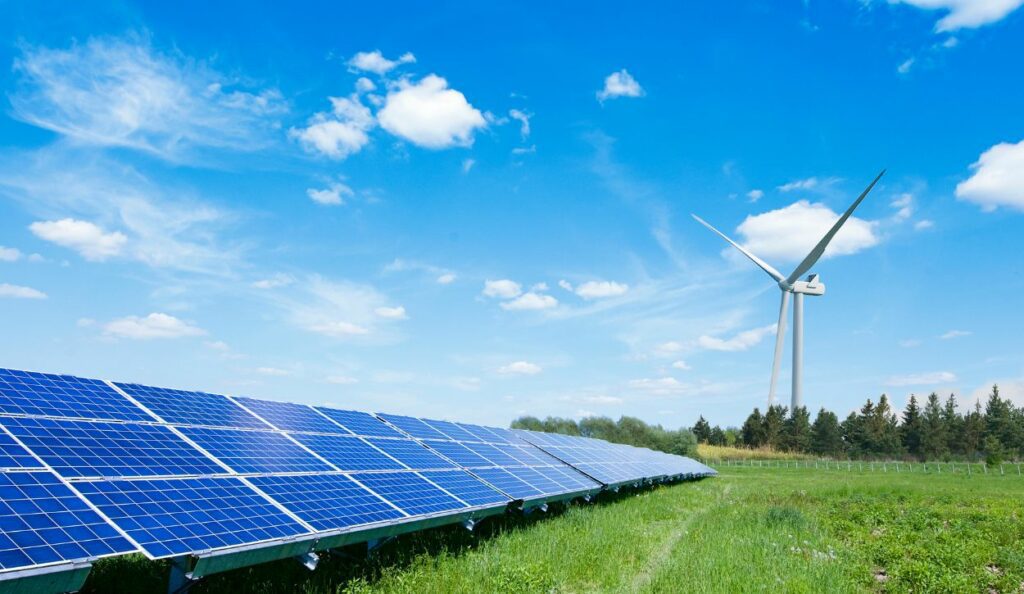Wind vs. Solar – Comparing Renewable Energy Sources
The wind and sun are two of the most important renewable energy sources, and modern engineering has enabled solar panels and wind turbines to be used in both large-scale and residential applications. Both types of renewable energy have their advantages and disadvantages, ultimately serving as complementary energy sources. The decision regarding which power source to pursue will come down to the surrounding environment and the goal you have in mind. And this discussion is sure to change as additional innovations in green energy sources emerge.
Currently, wind turbines outperform solar panels in terms of power and efficiency, but solar energy is more accessible to homeowners and both energy sources benefit from ongoing improvements in technology. The benefits of solar panels vs. wind turbines depend on different models and climates (among other factors), but here are a few fundamental comparison points to consider:

Performance Differences between Solar Panels and Wind Turbines

Perhaps the most important comparison point between solar panels and wind turbines is how successfully they convert light and kinetic energy into electricity. While both energy sources have their pros and cons, wind turbines are currently more powerful and efficient. Additionally, there are many regions where wind provides a more constant source of energy than solar. However, there are also regions where the predictability of sunlight makes solar panels a more viable option. Read on for more details about how wind power and solar power stack up.
Power Capacity
The power capacity of wind turbines and solar panels varies widely between residential and utility-scale models, and between the many different designs available for each energy source. But overall, wind turbines are currently capable of reaching much higher power capacities, especially when factoring in massive, ocean-based turbines.
To lend perspective, the most powerful solar farm in the world, Bhadla Solar Park, has a power capacity of around 2GW. Located in Rajasthan, India, this solar farm spans 22 square miles and comprises over 10 million solar panels.1 The Gansu Wind Farm in China, the largest wind farm in the world, has a current power capacity of nearly 8GW with a planned capacity of 20GW. Also known as the Jiuquan Wind Power Base, this project will feature 7,000 individual turbines spread across multiple phases.2
Efficiency
Efficiency is a measure of how well a wind turbine or solar panel converts energy into electricity. On average, utility-scale solar panels are 17-20% efficient.3 A solar panel works using only certain wavelengths, and it loses energy throughout the conversion process as well.4 Wind turbines, on the other hand, work at an average of 20-40% efficiency.5 The overall efficiency of both renewable energy sources depends on the particular model at hand, what material it is made of, where it is installed, and other factors. But ultimately, modern wind turbines have proven to be a more efficient form of energy production than solar panels.
Check out our guide: How Solar Panels Convert Sunlight to Electricity
Climate
One of the most obvious differences between wind turbines and solar panels is that their energy output depends on different weather conditions and climates. Wind turbines in the United States, for example, are concentrated in the windy plains of the central U.S., with new projects being developed offshore to harness strong wind speeds over the ocean. An important functionality of wind turbines is that they can produce energy around the clock – as long as the wind blows, the turbines will continue to produce electricity.

U.S. Wind Turbine Database displaying wind projects in the United States 6
Solar panels perform at their best in the presence of direct sunlight, so it’s no surprise that the state with the most solar photovoltaic (PV) panels is California.7 But while warm regions are conducive to long, sunny days, don’t forget that energy generation from solar photovoltaics has everything to do with direct sunlight – not heat. Solar panels technically function better in cold climates, as long as they have enough sunlight and are not obstructed by snow or ice.

U.S. Solar Photovoltaic Database displaying solar farms in the United States 8
Given that solar panels and wind turbines operate under different conditions (and are even affected by seasons and the time of day), studies show there could be great success in installing complementary solar and wind farms in certain regions of the world. Texas, for example, is a state that can achieve high complementarity between solar and wind farms, as it has both a windy and sunny climate.9
Costs of Solar vs. Wind Power

To fully understand the cost of any energy project – solar or wind, residential or commercial – project managers or homeowners will need current estimates directly from manufacturers, supply chain partners, and other key parties. Federal and state tax incentives, grants, and subsidies also play a large role in determining the total expense. But thanks to ongoing investments in clean energy over the last few decades in particular, there is enough data to get a sense of the average costs of these projects.
Small-Scale Energy Projects
The cost of installing residential solar panels depends on a variety of factors, including your location, supply chain costs, labor, and the federal tax incentives available to you. According to EnergySage, the average cost-per-watt for a residential solar project is about $3 before tax incentives.10 For a 10kW residential project, this amounts to roughly $25,000-$35,000 before federal assistance. With federal tax credits, the project might end up in the $18,000-25,000 range.11 Little to no maintenance is needed for home solar panels – your main concern will be keeping the panels clear from significant obstructions that can interfere with their performance, such as heavy snow or the build-up of leaves or pollen.
Residential wind power carries a similar price tag to a home solar system, with estimated costs of around $3,000 per kW (or $30,000 per 10 kW) apart from any state or federal incentives.12 You’ll also want to factor in possible maintenance costs over the years, which depend on the home wind turbine model and your particular environment. Keep in mind that the size of wind turbines is proportional to their power capacity – the more energy you want to receive from wind power, the more space you will need for a large turbine.
Utility-Scale Energy Projects
How to accurately estimate energy costs is an ongoing discussion. Upfront purchasing and installation costs provide hard numbers, but they don’t account for other expenses over the course of a unit’s lifespan. Calculating the levelized cost of energy (LCOE) is one way to track numbers more holistically. The LCOE takes into consideration factors such as long-term operating and maintenance costs. According to a study published in 2022, the levelized cost of energy for U.S. utility-scale wind projects in 2020 was $32/MWh (megawatt-hour), and $34/MWh for solar projects.13

Keep in mind that any parties pursuing a wind or solar project will need to factor in federal and state subsidies and any other programs that may significantly impact the cost of these projects. Both solar and wind have come a long way in terms of cost-effectiveness, and we can hope that technological advancements will continue this trend.
Best Applications for Wind Energy and Solar Energy

Currently, solar panels are a more reasonable option for most homeowners who are looking to benefit from a renewable source of energy. Their low profile allows for installation with less space, ideal for urban areas. Meanwhile, wind turbines are making strides in utility-scale settings. In 2022, wind power was responsible for 10.3% of all utility-scale electricity generation in the United States, compared to 3.3% from solar photovoltaic energy systems.14
With continued innovation in renewable energy, advancement in solar and wind power technology may change the playing field. In the meantime, the United States continues to invest in both forms of renewable energy. This endeavor diversifies the nation’s energy sources and sustains jobs in manufacturing, construction, maintenance, and logistics with each new project.

Titan Worldwide Transports Equipment for Power Projects
With extensive experience in heavy haul transportation, Titan has the industry knowledge and equipment necessary to get solar panel and wind turbine components where they need to go. Whether you’re building a solar farm or developing a wind project, contact the experts at Titan for assistance with route planning and delivery of these valuable pieces of equipment.
Endnotes
1. https://www.solarsquare.in/blog/bhadla-solar-power-plant/
2. https://www.power-technology.com/features/feature-biggest-wind-farms-in-the-world-texas/
3. https://www.energysage.com/solar/what-are-the-most-efficient-solar-panels-on-the-market/
4. https://www.epa.gov/sites/default/files/2019-08/documents/wind_turbines_fact_sheet_p100il8k.pdf
5. https://eerscmap.usgs.gov/uswtdb/viewer/#3.63/39.7/-92.16
6. https://www.eia.gov/electricity/data/browser/#/topic/0?agg=2,1,0&fuel=0004&geo=vvvvvvvvvvvvo&sec=g&freq=M&start=200101&end=202305&ctype=linechart<ype=pin&rtype=s&maptype=0&rse=0&pin=
7. https://eerscmap.usgs.gov/uspvdb/viewer/#3.59/39.58/-98.54
8. https://www.vox.com/science-and-health/2019/1/7/18167351/texas-energy-solar-wind-renewables-ercot
9. https://www.energysage.com/local-data/solar-panel-cost/
10. https://www.energysage.com/about-clean-energy/wind/small-wind-turbines-overview/
11. https://doi.org/10.1016/j.isci.2022.104378
12. https://www.eia.gov/tools/faqs/faq.php?id=427




